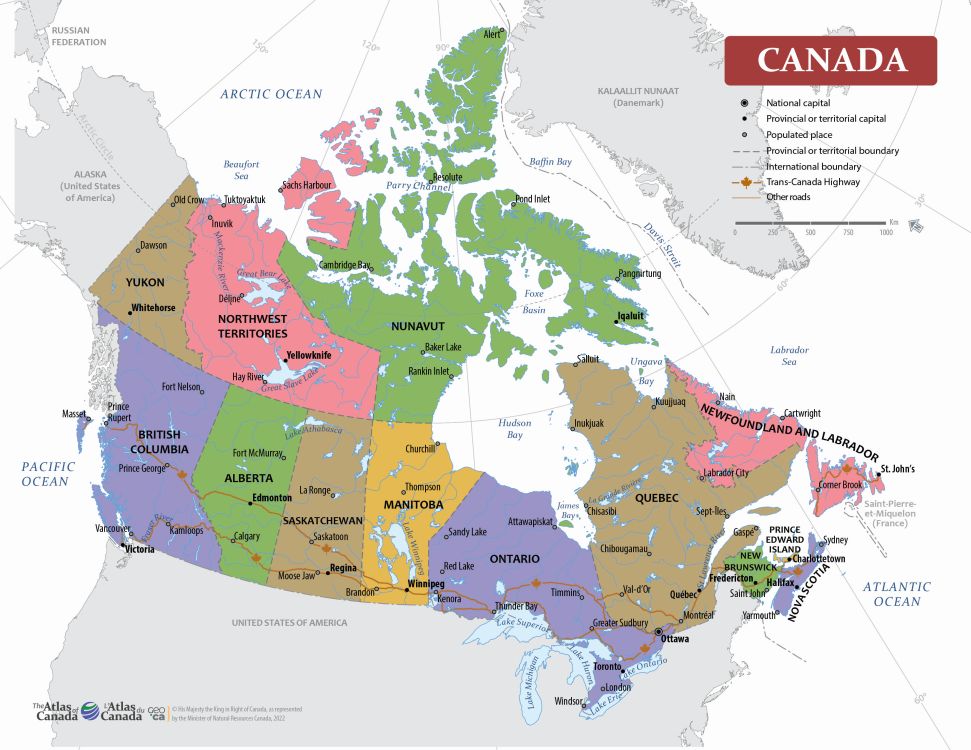Canada- legal definition
“Includes” legal definition is critical to understand:
The legal definition of “Includes” is different than the way we use it in everyday life: “to shut in, keep within. To confine within, hold as in an inclosure, take in, attain, shut up, contain, inclose, comprise, comprehend, embrace, involve.” (from Black’s Law, 4th edition) In other words, when “includes” is used in legal terms, it means “only”. To confirm this point, looking at legal maxims, “Inclusio…The inclusion of one is the exclusion of another.” and “The certain designation of one person is an absolute exclusion of all others.” https://archive.org/details/acollectionlega00pelogoog/page/n137/mode/2up (page 118 of “A Collection of Legal Maxims in Law and Equity” by S.S. Peloubet from 1880) https://law.en-academic.com/9826/inclusio_unius_est_exclusio_alterius, as well as a number of other sources if you want to look it up.
The following illustrates that “Canada” only exists on water. The definition of “Canada” in Section 35(1) of the federal “Interpretation Act is: “Canada, for greater certainty, includes the internal waters of Canada and the territorial sea of Canada; (Canada)”. https://www.canlii.org/en/ca/laws/stat/rsc-1985-c-i-21/latest/rsc-1985-c-i-21.html?searchUrlHash=AAAAAQAUImludGVycHJldGF0aW9uIGFjdCIAAAAAAQ&resultIndex=1
“Internal waters”, as per the Interpretation Act, are:
internal waters,
- (a) in relation to Canada, means the internal waters of Canada as determined under the Oceans Act and includes the airspace above and the bed and subsoil below those waters, and
- (b) in relation to any other state, means the waters on the landward side of the baselines of the territorial sea of the other state; (eaux intérieures)
The Oceans Act states: 6 The internal waters of Canada consist of the waters on the landward side of the baselines of the territorial sea of Canada.
Regarding “territorial sea”, the Interpretation Act states it is:
territorial sea,
- (a) in relation to Canada, means the territorial sea of Canada as determined under the Oceans Act and includes the airspace above and the seabed and subsoil below that sea, and
- (b) in relation to any other state, means the territorial sea of the other state as determined in accordance with international law and the domestic laws of that other state; (mer territoriale)
From the Oceans Act:
4 The territorial sea of Canada consists of a belt of sea that has as its inner limit the baselines described in section 5 and as its outer limit
- (a) subject to paragraph (b), the line every point of which is at a distance of 12 nautical miles from the nearest point of the baselines (which basically means from the shoreline to 12 nautical miles out to sea); or
- (b) in respect of the portions of the territorial sea of Canada for which geographical coordinates of points have been prescribed pursuant to subparagraph 25(a)(ii), lines determined from the geographical coordinates of points so prescribed.

Determination of the baselines
5 (1) Subject to subsections (2) and (3), the baseline is the low-water line along the coast or on a low-tide elevation that is situated wholly or partly at a distance not exceeding the breadth of the territorial sea of Canada from the mainland or an island. (Means where low tide sits is the baseline.)
CANADA STARTS AT THE POINT OF LOW TIDE (THE BASELINE) AND GOES OUT TO SEA 12 NAUTICAL MILES.
This one sounds like they are claiming the beaches that are exposed during low tide:
Low-tide elevations
(4) For the purposes of this section, a low-tide elevation is a naturally formed area of land that is surrounded by and above water at low tide but submerged at high tide.
person, or any word or expression descriptive of a person, includes a corporation; (personne)
province means a province of Canada, and includes Yukon, the Northwest Territories and Nunavut; (province)
territory means Yukon, the Northwest Territories and Nunavut; (territoires)
From the Oceans Act, the definitions of “federal laws” and “law” are as follows (note that only the Legislatures of Yukon, Northwest Territories and Nunavut are mentioned, confirming that what we think of as the ten provinces are not a part of things):
federal laws includes Acts of Parliament, regulations as defined in subsection 2(1) of the Interpretation Act and any other rules of law within the jurisdiction of Parliament, but does not include laws of the Legislature of Yukon, of the Northwest Territories or for Nunavut; (droit)
law, in respect of a province, includes a law or rule of law from time to time in force in the province, other than federal laws, and the provisions of any instrument having effect under any such law; (droit)
From Canada’s “Citizenship Act” https://www.canlii.org/en/ca/laws/stat/rsc-1985-c-c-29/latest/rsc-1985-c-c-29.html?searchUrlHash=AAAAAQARImNpdGl6ZW5zaGlwIGFjdCIAAAAAAQ&resultIndex=1:
child includes a child adopted or legitimized in accordance with the laws of the place where the adoption or legitimation took place; (enfant)
citizen means a Canadian citizen; (citoyen)
citizenship means Canadian citizenship; (citoyenneté)
Interpretation
(2) For the purposes of this Act,
- (a) a person is deemed to be born in Canada if the person is born on a Canadian vessel as defined in section 2 of the Canada Shipping Act, 2001, or on an aircraft registered in Canada under the Aeronautics Act and regulations made under that Act;
The “Canada Shipping Act, 2001” defines Canadian Vessel as follows:
Canadian vessel means a vessel that is registered or listed under Part 2 (Registration, Listing and Recording) or that is exempted under the regulations from the registration requirement in subsection 46(1). (bâtiment canadien)
Citizenship is effectively a ship to your person uses to navigate the waters of Canada.
From the Canada Shipping Act: qualified person means (a) a Canadian citizen or a permanent resident within the meaning of subsection 2(1) of the Immigration and Refugee Protection Act; or (b) a corporation incorporated under the laws of Canada or a province. (personne qualifiée)
From the Territorial Lands Act: land includes mines, minerals, easements, servitudes and all other interests in real property; (terre) https://laws-lois.justice.gc.ca/eng/acts/T-7/FullText.html From the same Act: territorial lands means lands, or any interest in lands, in the Northwest Territories or Nunavut that are vested in the Crown or of which the Government of Canada has power to dispose. (terres territoriales) Interestingly, they have left out the Yukon in this one.
From B.C.’s Land Surveyors Act: “land” includes foreshore and land covered by water; https://www.canlii.org/en/bc/laws/stat/rsbc-1996-c-248/latest/rsbc-1996-c-248.html?searchUrlHash=AAAAAQAUImxhbmQgc3VydmV5b3JzIGFjdCIAAAAAAQ&resultIndex=1
ALL OF THESE ACTS ONLY TALK ABOUT WATER. NO LAND. SO- WHAT IS THE NAME OF THE LAND WE LIVE ON?
MC, DB



